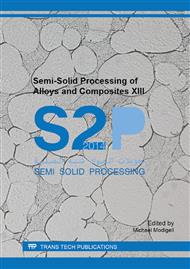p.366
p.374
p.381
p.389
p.397
p.405
p.412
p.418
p.426
Effect of Semi-Solid Processing on Iron-Bearing Intermetallic Compounds in A380 Aluminum Alloy
Abstract:
Al-Si-Fe alloys are a general purpose of die casting alloys, widely used to manufacture automotive parts. Forming this alloy in semi-solid state can eliminate important problems in die casting process. In the present work, low superheat melt was employed to produce modified microstructure and non-dendritic A380 alloy feed stocks. The melt was cast on a cooling slope plate at 615 °C to obtain ingots. Then, ingots are thixoformed using a hydraulic press after heating them at 570 °C for 15 minutes, yielding a microstructure with predominantly α–Al globules, Si particles, and modified β-phase intermetallic compounds. The effect of semi-solid processing on the morphology, size, and distribution of iron-bearing intermetallics was studied. The results of image analysis of the samples showed that by using semi-solid method, the shape factor of α-Al phase improved, and iron containing intermetallics were modified in size and distribution. These changes in the aspect ratio and redistribution of the intermetallics improved the mechanical properties such as hardness of the products.
Info:
Periodical:
Pages:
397-404
Citation:
Online since:
September 2014
Authors:
Keywords:
Price:
Сopyright:
© 2015 Trans Tech Publications Ltd. All Rights Reserved
Share:
Citation:


